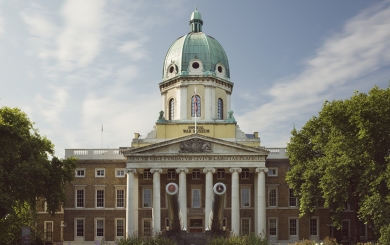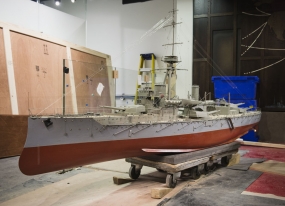Difference between revisions of "Imperial War Museum"
From Londonhua WIKI
(→First World War Galleries) |
(→Second World War Galleries) |
||
| Line 58: | Line 58: | ||
<br><br> | <br><br> | ||
=Second World War Galleries= | =Second World War Galleries= | ||
| − | ==V-2 Rocket | + | ==V-2 Rocket== |
| + | The V-2 Rocket was invented by Germany during the second World War. It is the first long range ballistic missile ever invented. It is the first ship to ever capture footage from space. It was invented by Wernher von Braun who later invented the Saturn V rocket for the United States. (pics will come) | ||
=The Holocaust Exhibition= | =The Holocaust Exhibition= | ||
Revision as of 15:10, 22 May 2017
Imperial War Museum
 Representative Article Image | |
| Imperial War Museum | |
|---|---|
| Attributed to Imperial War Museum | |
| Year | c. 1917 |
| Dimensions | 55.2 cm × 43.8 cm ( 21 3⁄4 in × 17 1⁄4 in) |
| Location | Imperial War Museum, London |
Overview
The Imperial War Museums is series of 5 museums located throughout England which holds a large collection of public and private documents, photographs, videos, and film material, and oral history recordings, an extensive library, a large art collection, and examples of military vehicles and aircraft, equipment, and other artifacts.The London location has a focuses on people's experiences and stories from WWI to current day modern day. It has several permanent exhibits such as the World War I exhibit which focuses on the sacrifices that many countries made while fighting the war, the Holocaust Exhibition, and the Secret War Exhibition.
Contents
Secret War
Secret War is an exhibit revealing the covert operations departments in Britain. These five departments are MI5, MI6, Secret Communications, SOE, and Secret Soldiers, each with their own specialty. Together, they provide critical intelligence to Britain to protect the country and its assets and act on this intelligence.
MI5
Military Intelligence 5 (MI5) or otherwise known as the Security Service protects Britain against espionage, terrorism or other forms of sabotage within the country. While MI5 was established in 1909 it was not until 1989 that its role was formally defined in the Security Service Act. Britain was one of the few European powers going into the twentieth century without a secret service. However, fear of Germany took over and the War Office's Secret Service Bureau was formed. MI5 came from the "home" department of this bureau. Despite being new and small, the department apprehended 12 German spies by the start of World War I. During the war the department was designated as MI5, acquired 21 agents and grew greatly in size. After the war focus shifted to Irish Nationalism, the threat of communism and right wing extremism. MI5 helped carry out surveillance on fascist and communist organizations that were acting as a front for Nazi and Soviet espionage. During World War II they went on the offensive due to the German threat. Sixteen enemy spies were executed and forty-seven others were "turned" into double agents as part of "The Double Cross System". MI5 also collaborated with MI6 and foreign secret services to defend allies against espionage and create a network of double agents. During the Cold War, MI5 worked hard to defend the country against Soviet spies and British citizens under their control. Starting in the 1970s concern over terrorism grew and MI5 expanded to fight that as well.
MI6
Military Intelligence 6 (MI6), the Secret Intelligence Service, was created in 1909 and formally defined in 1994 in the Intelligence Services Act. Its purpose is to collect intelligence on foreign activity and act on it. MI6 was formed from the other department of the War Office's Secret Service Bureau, the foreign department. Going into World War I the objective was to gain information on German naval construction as well as any plans to invade Britain. During the war the department was designated as MI6. Their purpose was to establish networks of information and to thwart the efforts of Germans in neutral countries. The most successful intelligence network was "La Dame Blanche" consisting of almost 1000 informants. After the war the focus was on monitoring the Soviet Union and fighting the spread of communism. As World War II approached, aerial photographic reconnaissance became important. At the start of the war, MI6 suffered due to a shortage of staff and funds, the kidnapping of two senior officers and the robbery of its communications system by the Germans. They recovered quickly, however, thanks to valuable signals intelligence, an influx of funds and foreign dissidents forming information networks. Post-war, MI6 worked to destabilize the Soviet Union and turn members of the Warsaw Pact. Since the end of the Cold War their goals have changed but the purpose remains to collect intelligence on foreign threats.
Secret Communications
SOE
Secret Soldeirs
First World War Galleries
 The restored HMS Hercules model, shortly before its installation in the First World War Galleries. | |
| Attributed to Imperial War Museum | |
| Location | Imperial War Museum, London |
|---|---|
This model she had been displayed in the Imperial War Museum's Naval Gallery since 1936 but on Friday 31st January 1941 a huge incident happened. A group of workmen in the museum were repairing blast damage from earlier air raids, around midday they stopped for lunch and shortly afterwards a German bomber dropped five bombs in the locality. Had the bombs fallen a few minutes earlier the workmen would have all been killed. However, the Imperial War Museum's Naval Gallery was destroyed. Six showcases of ship's badges had their contents blasted cleaned out of the building being thrown off to the park and events the museum's roof. The bomb blast shattered the Hercules model glass showcase and "turned the ship's masts and other fittings into a mass of tangled wreckage".[1] In 2010, work started to slowly restore the Hercules model so that it could go on display in the museum once again.It is now available for visitors from all around the world to admire in the First World War Galleries of the Imperial War Museum London.
Like many ships of the Grand Fleet, Hercules drew its name from classical mythology. In the Greek myths, Herakles, known to the Romans as Hercules, was a hero of legendary strength who overpowered and outwitted his enemies. Some ships' names, like Hercules, evoked legendary figures known for their combat prowess or martial qualities. Examples include the battleships Bellerophon and Orion, the slayer of monsters and the huntsman respectively, or the light cruiser Bellona, the Roman goddess of war. Others ships took names that suggested perhaps surprising qualities for warships – the light cruisers Comus and Calliope remembered in their names the drunken god of wild partying, and the goddess muse of poetry and eloquence.[2]
Second World War Galleries
V-2 Rocket
The V-2 Rocket was invented by Germany during the second World War. It is the first long range ballistic missile ever invented. It is the first ship to ever capture footage from space. It was invented by Wernher von Braun who later invented the Saturn V rocket for the United States. (pics will come)
The Holocaust Exhibition
This exhibition goes from the year 1933 to the year 1945 focuses on the Nazi regime and their persecution of Jews in Europe. It examines how and why Hitler rose to power and how it ultimately affected the population of Europe forever. This exhibit has photographs, diaries, clothing, toys, and films of people who experienced this tragedy. The exhibit and the personal accounts of survivors are a painful reminder of the tragedy of war and how it had devastated the lives of many.
Family in Wartime
This exhibit focuses on how family life was affected primarily during World War II. One of the main focuses of the exhibit is to give visitors a better understanding of how daily life in Britain changed during the war. Things such as air raids, rations, and preparedness plans were all part of life especially in London itself. The exhibit holds many primary documents such as newspapers that brings the war experience a little closer to the visitor. The exhibit also has a continuous rolling film of the war which was described as commonplace to keep citizens up to date and connected to the war effort.
Syria: A Conflict Explored
This is a temporary exhibit that is opened till September 2017. Part of the Conflict Now program, this exhibit explores the beginnings, timeline and the human impact of the things going on in Syria. The conflict in Syria started in 2011 and is still going on today. According to the War museum website, 'The ongoing conflict has already lasted longer than the Second World War. As a result, nearly half a million people have been killed. Almost eleven million – half the pre-war population – have been forced from their homes and much of the country lies in ruins.' [3] This sections shows a collection of war objects, and stories of real people that show the devastation that Syria has faced through this.
References
- ↑ J. (2016, March 16). HMS Hercules At War And On Display. Retrieved May 22, 2017, from http://www.iwm.org.uk/history/hms-hercules-at-war-and-on-display
- ↑ J. (2016, March 16). HMS Hercules At War And On Display. Retrieved May 22, 2017, from http://www.iwm.org.uk/history/hms-hercules-at-war-and-on-display
- ↑ K. (2017, March 31). Syria: A Conflict Explored. Retrieved May 22, 2017, from http://www.iwm.org.uk/exhibitions/iwm-london/syria-a-conflict-explored
External Links
If appropriate, add an external links section
Image Gallery
If appropriate, add an image gallery
</nowiki>